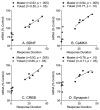Activity-dependent plasticity of spinal locomotion: implications for sensory processing
- PMID: 19955866
- PMCID: PMC2790155
- DOI: 10.1097/JES.0b013e3181b7b932
Activity-dependent plasticity of spinal locomotion: implications for sensory processing
Abstract
The lumbosacral spinal cord of mammals contains the neural circuitry capable of generating full weight-bearing locomotion of the hind limbs without any supraspinal input. One or more interventions, for example, pharmacological, epidural stimulation, and/or locomotor training, however, are necessary to gain access to and modulate the properties of this circuitry and to facilitate recovery of full weight-bearing locomotion after spinal cord injury.
Figures





References
-
- Alvarez FJ, Taylor-Blake B, Fyffe RE, De Blas AL, Light AR. Distribution of immunoreactivity for the beta 2 and beta 3 subunits of the GABAA receptor in the mammalian spinal cord. J Comp Neurol. 1996;365:392–412. - PubMed
-
- Barbeau H, Rossignol S. Recovery of locomotion after chronic spinalization in the adult cat. Brain Res. 1987;412:84–95. - PubMed
-
- Bravo A, Bigbee AJ, Roy RR, Edgerton VR, Tobin AJ, Tillakaratne NJK. Gamma2 subunit of the GABAA receptor is increased in lumbar astrocytes in neonatally spinal cord transected rats. Soc Neurosci Abstr. 2002;28 Program No. 853.5.
Publication types
MeSH terms
Grants and funding
LinkOut - more resources
Full Text Sources
Medical

